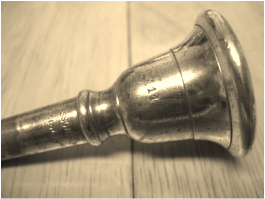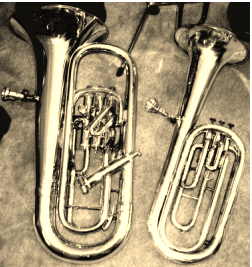
Teaching Philosophy
Each student is a valuable human being and is unique. While my role as a teacher includes imparting musical knowledge about repertoire, technical information about instruments and equipment and the like, it is my goal to provide each student with the tools to become aware of his or her learning styles. This includes showing students how to practice effectively, as well as teaching them to respond to adversity and high-pressure situations like auditions and recital performances.
A goal oriented, methodical approach is beneficial to maximize a student’s progress. While I do not have a set regimen for everyone, as each student is different and has varied needs, there are common areas such as scales, technical studies, etudes, excerpts and solo repertoire. I prefer to organize lessons and assignments so students know exactly what the assignment is, why they are doing the particular task, the recommended minimum practice time and how the assignment will be evaluated at the next lesson.
I believe students learn best when they let the conscious part of the brain get out of the way and let the non-thinking parts of the mind and body respond naturally to appropriate stimuli which is the sharply focused mental command of the musical product. Conversely, I feel that a musician cannot produce a musically satisfying performance without a clear concept on what he or she wants to sound like. My role when it comes to teaching how to play the instrument, therefore, is to be the student’s guide. It is vitally important for me to model musical examples for the student, as well as encourage them to listen to as many live concerts and recordings as possible. When students start internalizing the mechanics of how they play or begin a critical internal dialogue, it is my job to get them back on track thinking about the musical product he or she wishes to produce.
When students discover how they learn and how to do it without blocking themselves with internal dialogue or unnecessary isometric muscular tension, playing becomes easy and music a real joy.
copyright 2010
Each student is a valuable human being and is unique. While my role as a teacher includes imparting musical knowledge about repertoire, technical information about instruments and equipment and the like, it is my goal to provide each student with the tools to become aware of his or her learning styles. This includes showing students how to practice effectively, as well as teaching them to respond to adversity and high-pressure situations like auditions and recital performances.
A goal oriented, methodical approach is beneficial to maximize a student’s progress. While I do not have a set regimen for everyone, as each student is different and has varied needs, there are common areas such as scales, technical studies, etudes, excerpts and solo repertoire. I prefer to organize lessons and assignments so students know exactly what the assignment is, why they are doing the particular task, the recommended minimum practice time and how the assignment will be evaluated at the next lesson.
I believe students learn best when they let the conscious part of the brain get out of the way and let the non-thinking parts of the mind and body respond naturally to appropriate stimuli which is the sharply focused mental command of the musical product. Conversely, I feel that a musician cannot produce a musically satisfying performance without a clear concept on what he or she wants to sound like. My role when it comes to teaching how to play the instrument, therefore, is to be the student’s guide. It is vitally important for me to model musical examples for the student, as well as encourage them to listen to as many live concerts and recordings as possible. When students start internalizing the mechanics of how they play or begin a critical internal dialogue, it is my job to get them back on track thinking about the musical product he or she wishes to produce.
When students discover how they learn and how to do it without blocking themselves with internal dialogue or unnecessary isometric muscular tension, playing becomes easy and music a real joy.
copyright 2010
Practice Log
| practice_log_s18.pdf | |
| File Size: | 47 kb |
| File Type: | |
Intonation
| just_intonation_-_chords.pdf | |
| File Size: | 875 kb |
| File Type: | |
Scales
| scale_patterns_for_the_euphonium_-_euphonium.pdf | |
| File Size: | 115 kb |
| File Type: | |
Lessons
If anyone is interested in private study on a low brass instrument, I offer the following options:
30 minute lesson - $20.00 US.
60 minute lesson - $35.00 US
Internet lessons - TBA*
Payment in cash or check drawn from a US bank required at the time of the lesson. * Details on Internet lessons coming soon.
I am also available for master classes and low brass section rehearsals. Please contact me to negotiate price.
If anyone is interested in private study on a low brass instrument, I offer the following options:
30 minute lesson - $20.00 US.
60 minute lesson - $35.00 US
Internet lessons - TBA*
Payment in cash or check drawn from a US bank required at the time of the lesson. * Details on Internet lessons coming soon.
I am also available for master classes and low brass section rehearsals. Please contact me to negotiate price.
Equipment

Mouthpieces
On occasion I'm asked for advice regarding mouthpieces ranging from what is a good mouthpiece for a beginner to what is appropriate for a college-level player. These questions are actually a complicated topic because of the many factors involved, which include facial structure, air capacity, level of the player, type of instrument, the size of the receiver and the kind of music to be performed, to name a few. Therefore, I think it may be best to speak in generic terms, at least in this venue. I have heard of two schools of thought: choose the largest mouthpiece you can play, and conversely, settle on the smallest mouthpiece you can tolerate. Either way, one must come to a size mouthpiece that is appropriate to his or her needs and ability.
For Beginner Players
Trombone: Bach 7C, Denis Wick 9B or Schilke 50
Euphonium: Bach 6-1/2 A, Denis Wick 6B or Schilke 50
I tend not to recommend specialty mouthpieces for beginning players. These mouthpieces are generally more expensive and are designed for a specific type of playing. Also, these mouthpieces often are made with advanced players in mind. A beginner may have trouble with a specialty mouthpiece and become unnecessarily frustrated.
For Intermediate Players
Many intermediate players continue to play a mouthpiece similar in size to the ones mentioned under beginner. Some players feel they need to upgrade their equipment to meet their needs. I've listed some options:
Trombone: Bach 6-1/2 AL to 5G, Wick 6AL to 5AL, Schilke 51
Euphonium: Bach 5G to 4G, Wick 5AL to 4AL, Schilke 51, Schilke 51D
For Advanced Players
By the time a musician becomes an advanced player, he or she usually has a well-developed concept of sound and has settled on one or two mouthpieces to address their needs. I've included some suggestions of mouthpieces. My musical experience is primarily on euphonium which is reflected in the choices in this section.
Trombone: Bach 5G, Bach 4G, Doug Elliott XT 104,I,I9 *
Euphonium: Bach 3G, Denis Wick - Steven Mead models SM4, SM3, SM Ultra 3, SM3X, Warburton Demondrae Thurman model, Alliance DC2, Doug Elliott Euph Series 104,I,I9, DEG Brian Bowman BB1 BT(bass shank) or EU (euphonium shank), Schilke 51D
* Many trombonists also use Greg Black, Ferguson, Hammond, Schilke, Wick and Greigo mouthpieces, usually within the 6-1/2 to 3G size range or classical playing and smaller for jazz and alto trombone.
On occasion I'm asked for advice regarding mouthpieces ranging from what is a good mouthpiece for a beginner to what is appropriate for a college-level player. These questions are actually a complicated topic because of the many factors involved, which include facial structure, air capacity, level of the player, type of instrument, the size of the receiver and the kind of music to be performed, to name a few. Therefore, I think it may be best to speak in generic terms, at least in this venue. I have heard of two schools of thought: choose the largest mouthpiece you can play, and conversely, settle on the smallest mouthpiece you can tolerate. Either way, one must come to a size mouthpiece that is appropriate to his or her needs and ability.
For Beginner Players
Trombone: Bach 7C, Denis Wick 9B or Schilke 50
Euphonium: Bach 6-1/2 A, Denis Wick 6B or Schilke 50
I tend not to recommend specialty mouthpieces for beginning players. These mouthpieces are generally more expensive and are designed for a specific type of playing. Also, these mouthpieces often are made with advanced players in mind. A beginner may have trouble with a specialty mouthpiece and become unnecessarily frustrated.
For Intermediate Players
Many intermediate players continue to play a mouthpiece similar in size to the ones mentioned under beginner. Some players feel they need to upgrade their equipment to meet their needs. I've listed some options:
Trombone: Bach 6-1/2 AL to 5G, Wick 6AL to 5AL, Schilke 51
Euphonium: Bach 5G to 4G, Wick 5AL to 4AL, Schilke 51, Schilke 51D
For Advanced Players
By the time a musician becomes an advanced player, he or she usually has a well-developed concept of sound and has settled on one or two mouthpieces to address their needs. I've included some suggestions of mouthpieces. My musical experience is primarily on euphonium which is reflected in the choices in this section.
Trombone: Bach 5G, Bach 4G, Doug Elliott XT 104,I,I9 *
Euphonium: Bach 3G, Denis Wick - Steven Mead models SM4, SM3, SM Ultra 3, SM3X, Warburton Demondrae Thurman model, Alliance DC2, Doug Elliott Euph Series 104,I,I9, DEG Brian Bowman BB1 BT(bass shank) or EU (euphonium shank), Schilke 51D
* Many trombonists also use Greg Black, Ferguson, Hammond, Schilke, Wick and Greigo mouthpieces, usually within the 6-1/2 to 3G size range or classical playing and smaller for jazz and alto trombone.

Instruments
Euphoniums
For Beginner Players
King 625 or 627 (3 valves, bell front or upright bell)
King 2266 or 2268 (4 valves, bell front or upright bell)
Yamaha YEP-211 (3 valves, bell front)
Yamaha YEP-201 (3 valves, upright bell)
For Intermediate Players
Non-compensating
King 2266 or 2268 (4 valves, bell front or upright bell)
King 2280 (4 valves, upright bell, bass trombone receiver)
Yamaha YEP-321 (4 valves, upright bell)
Besson BE1065 (3+1 valve configuration, non-compensating, upright bell, bass trombone receiver)
Compensating - These are very nice horns for professionals too
Yamaha YEP-642
Besson BE968
Besson BE967
For Advanced Players
For the most part, advanced college and professional players know the type of euphonium that works for them. Usually, a professional level euphonium is a 4 valve compensating instrument. The companies that produce professional level instruments are as follows:
Adams
Besson
Hirsbrunner*
Jupiter XO series
Miraphone
Stirling
Willson
Yamaha
There are some exceptions, of course. There are many euphonium players who sound great on non-compensating instruments or instruments with different valve configurations.
Non-compensating
King 2280
Yamaha 321**
Rotary valved horns
Alexander - various models
Miraphone - various models
Compensating
Willson 2727 (3 valve compensating)
Willson 2750 (3 valve compensating)
Willson 2750 (4 valve compensating, front facing valves)
Canadian Brass CB30 (4 valve compensating, front facing valves)
In the United States the name euphonium and baritone/baritone horn have been used interchangeably. This confusion in nomenclature has been greatly reduced in the past 20-30 years due to a handful of successful players who have been advocates for the euphonium. An actual baritone is quite different than the euphonium. Where the euphonium is a descendant of the bugle family, the baritone is derivative of the baritone saxhorn. As a result, the baritone is less conical and smaller bore/bell size. The sound is mellow, but lighter than the euphonium. For many players in the US, a real baritone is a specialty instrument primarily used in a British-style brass band. Because the baritone is a salient instrument of the British-style brass band, it is often called an English baritone in the United States. They are made with either 3 or 4 valves. The following companies make fine baritones:
Baritones
Besson
Sterling
Yamaha
Euphoniums
For Beginner Players
King 625 or 627 (3 valves, bell front or upright bell)
King 2266 or 2268 (4 valves, bell front or upright bell)
Yamaha YEP-211 (3 valves, bell front)
Yamaha YEP-201 (3 valves, upright bell)
For Intermediate Players
Non-compensating
King 2266 or 2268 (4 valves, bell front or upright bell)
King 2280 (4 valves, upright bell, bass trombone receiver)
Yamaha YEP-321 (4 valves, upright bell)
Besson BE1065 (3+1 valve configuration, non-compensating, upright bell, bass trombone receiver)
Compensating - These are very nice horns for professionals too
Yamaha YEP-642
Besson BE968
Besson BE967
For Advanced Players
For the most part, advanced college and professional players know the type of euphonium that works for them. Usually, a professional level euphonium is a 4 valve compensating instrument. The companies that produce professional level instruments are as follows:
Adams
Besson
Hirsbrunner*
Jupiter XO series
Miraphone
Stirling
Willson
Yamaha
There are some exceptions, of course. There are many euphonium players who sound great on non-compensating instruments or instruments with different valve configurations.
Non-compensating
King 2280
Yamaha 321**
Rotary valved horns
Alexander - various models
Miraphone - various models
Compensating
Willson 2727 (3 valve compensating)
Willson 2750 (3 valve compensating)
Willson 2750 (4 valve compensating, front facing valves)
Canadian Brass CB30 (4 valve compensating, front facing valves)
In the United States the name euphonium and baritone/baritone horn have been used interchangeably. This confusion in nomenclature has been greatly reduced in the past 20-30 years due to a handful of successful players who have been advocates for the euphonium. An actual baritone is quite different than the euphonium. Where the euphonium is a descendant of the bugle family, the baritone is derivative of the baritone saxhorn. As a result, the baritone is less conical and smaller bore/bell size. The sound is mellow, but lighter than the euphonium. For many players in the US, a real baritone is a specialty instrument primarily used in a British-style brass band. Because the baritone is a salient instrument of the British-style brass band, it is often called an English baritone in the United States. They are made with either 3 or 4 valves. The following companies make fine baritones:
Baritones
Besson
Sterling
Yamaha
